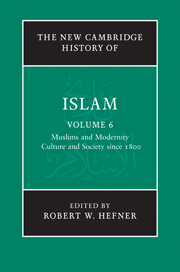Book contents
- Frontmatter
- 1 Introduction: Muslims and modernity: culture and society in an age of contest and plurality
- PART I SOCIAL TRANSFORMATIONS
- PART II RELIGION AND LAW
- PART III POLITICAL AND ECONOMIC THOUGHT
- 16 Islamic political thought
- 17 Women, family and the law: the Muslim personal status law debate in Arab states
- 18 Culture and politics in Iran since the 1979 revolution
- 19 Modern Islam and the economy
- PART IV CULTURES, ARTS AND LEARNING
- Glossary
- Bibliography
- Index
- References
18 - Culture and politics in Iran since the 1979 revolution
from PART III - POLITICAL AND ECONOMIC THOUGHT
Published online by Cambridge University Press: 28 March 2011
- Frontmatter
- 1 Introduction: Muslims and modernity: culture and society in an age of contest and plurality
- PART I SOCIAL TRANSFORMATIONS
- PART II RELIGION AND LAW
- PART III POLITICAL AND ECONOMIC THOUGHT
- 16 Islamic political thought
- 17 Women, family and the law: the Muslim personal status law debate in Arab states
- 18 Culture and politics in Iran since the 1979 revolution
- 19 Modern Islam and the economy
- PART IV CULTURES, ARTS AND LEARNING
- Glossary
- Bibliography
- Index
- References
Summary
1979–2004
Introduction
Iranian culture and society were profoundly affected by the mass revolution of 1978–9. The victory of the revolution in February 1979 was possible as the result of an ultimately incompatible coalition of forces, ranging from various leftist and communist parties, through the liberal democrats of the National Front, the Islamic democrats of the Iran Liberation Movement, to the clerical and non-clerical followers of Ayatollah Ruhollah Khomeini. In the demonstrations of 1978 and to a degree even before, non-clerical forces increasingly allied with the charismatic Khomeini, who was the only person with mass popularity. Only the religious forces had had a venue in mosques and religious gatherings to voice anti-regime language, often in the coded form of references to the oppressors and killers of the third Shīʿī imam, Ḥusayn. The mythical elaboration and re-enactment of Ḥusayn’s martyrdom at Karbalāʾ, Iraq, at the hands of the Umayyad caliph Yazīd, which in peaceful times was used to assure Ḥusayn’s intercession for believers, became the cultural expression and rallying cry for revolutionary action against the shah’s tyranny.
Secularists’ and democrats’ acceptance of Khomeini’s leadership was facilitated by the young leaders who spoke in his name in 1978 – Abuʾl-Ḥasan Banī Ṣadr, Ṣādiq Quṭbzāda and Ibrāhīm Yazdī – all of whom presented the cultural–political synthesis elaborated in the 1970s of a modernised, anti-imperialist version of Islam.
- Type
- Chapter
- Information
- The New Cambridge History of Islam , pp. 438 - 472Publisher: Cambridge University PressPrint publication year: 2010
References
- 3
- Cited by

